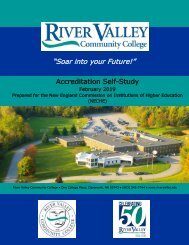Create successful ePaper yourself
Turn your PDF publications into a flip-book with our unique Google optimized e-Paper software.
Committees for each Initiative met throughout the Spring of 2017 to develop objectives<br />
and the measurements they would use to evaluate progress towards completion of each<br />
objective. Due to leadership changes in Fall of 2017, work on the strategic plan slowed.<br />
This was a necessary step due to the search for a full-time President. Under President<br />
Williams, the 2018-2021 Strategic Plan was completed and approved by the college<br />
community in late Fall 2018.<br />
In the recent past due to instability in the offices of President and BAO, <strong>RVCC</strong> engaged in a<br />
period of reactionary spending instead of proactive planning for budgetary needs. This<br />
spending resulted in a deficit, and a workforce reduction in Spring of 2017. Under the<br />
current administration, focus and organization of college finances has shifted significantly<br />
to a strategic spending policy resulting in a balanced budget at <strong>RVCC</strong>. The BAO is<br />
transparent in how budgets are created, the many factors that need to be considered in<br />
budgeting, and most importantly, now involves each Department Chair, Division Director,<br />
and Program Director in developing their own budgets. The budget process has been<br />
clarified for the college community and is much more focused on creating a balanced<br />
budget with regular evaluation of income and expenses, resulting in the College once again<br />
operating in the black. This updated process of financial planning and evaluation is<br />
explained in detail in Standard Seven.<br />
An additional challenge in planning has been the expansion of the College through the<br />
Academic Center in Lebanon. Previously, when the College consisted of the Claremont<br />
campus and the Keene Academic Center, the roles of each location were clear. The<br />
College has struggled to find an identity for the LAC, however. Original plans for the LAC<br />
indicated that it would be the center for Business and Technology. After completion it was<br />
discussed that the LAC would house some Allied Health programs. These plans were<br />
discussed at the administrative level and did not include conversations with Program<br />
Directors. When Program Directors were included in these conversations it was clear that<br />
due to the lack of lab space at the LAC, national accreditation requirements, and<br />
enrollment trends, it was not going to be feasible to duplicate these programs at the LAC.<br />
President Williams’ administration has continued these open conversations to appropriately<br />
plan and clarify the roles of the Academic Centers within the College as a whole. These<br />
plans have included the expansion of non-credit offerings and eliminating duplication of<br />
classes at the LAC that are offered in Claremont. The VPAA along with Department Chairs<br />
and Program Coordinators have focused on classes that meet the needs of the Lebanon<br />
area, and together they are working on identifying a major that is exclusive to the LAC.<br />
The mathematics co-requisite project provides evidence of planning at the academic level;<br />
outcomes of which are explained in greater detail in Standard Five. While this is only one<br />
example of academic planning, it is one of the projects the College is proudest of and has<br />
that impacted students at all levels. In 2016, the Chancellor of CCSNH signed on to<br />
Complete College America, a non-profit organization that works with states to improve<br />
access to quality career certificates and degrees. In March of 2016, the <strong>RVCC</strong> Math<br />
Department Chair attended the National Academy for Scaling Co-Requisite Remediation in<br />
Atlanta, GA with a team from CCSNH. There, the team heard about co-requisite projects<br />
from colleges across the nation and began developing a system-wide co-requisite plan.<br />
That plan was adapted at each of the CCSNH colleges independently.<br />
17 | P a g e





